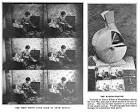| Date | Text | |
|---|---|---|
05 Feb 1861

Stereoscope patent |
Stereoscope patent In 1861, a stereoscope design that may be regarded as the first U.S. precursor to the peep show machine was patented by Samuel D. Goodale of Cincinnati (No. 31,310). Stereoscopic pictures were fastened by one edge to an axis in such a way that they stood out like spokes. As it was turned by hand, different scenes appeared to be viewed, each one held steady against a detent projecting from the interior of the case before the lens, until flipped away as the shaft rotated to almost instantly reveal the next scene. The equipment was easily portable, and the lens holder, reflector and diffusing glass could be compactly folded within the case. The case was made in two sections that could be opened to view and replace the scenes. |
|
05 Feb 1861

Kinematoscope |
Kinematoscope In 1861, a U.S. patent was issued for the kinematoscope - a photographic attempt to show motion - to Coleman Sellers of Philadelphia as an "improvement in exhibiting stereoscopic pictures of moving objects (No. 31,357). A series of still pictures with successive stages of action was mounted on blades of a paddle and viewed through slits passed under the lens of a stereoscope revolved at right angles. The pictures were were visible only in the cabinet. The picture was not seen whole at once, but only by degrees as the cylinder revolved. The inventor wished to show pictures such as human motion or the revolving wheels of machinery. He applied stereoscopic viewing to the existing principle of toy phatasmascopes using rotating discs. |